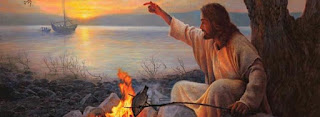If this is your first viewing, please see my Introduction before reading this.
The last four sections of the Bible in a Year blog, covering the whole of the Book of Revelation, are being uploaded together (just because I was without Internet access this week).
31 December. Revelation chapters 19-22
According to chapter 20, after all forms of evil are finally defeated, Christ returns to reign with his martyrs (but not the rest of humanity) for a symbolic period of a thousand years, after which all the dead are resurrected to be judged, and either live in paradise (described as the new Jerusalem – a magnificent and vast jewelled city with eternal light) or be thrown into the lake of fire (from which the popular idea of Hell arises).
But on what basis is this ultimate judgement made? Jesus says here: “To the thirsty I will give water as a gift from the spring of the water of life. Those who conquer will inherit these things, and I will be their God and they will be my children. But as for the cowardly, the faithless, the polluted, the murderers, the fornicators, the sorcerers, the idolaters, and all liars, their place will be in the lake that burns with fire and sulphur, which is the second death” (21:6-8). The contrast is between, on the one hand, those who are “thirsty” (that is, longing for God’s presence and help) and those who “conquer” (that is, overcome temptation, and persist in faith during trials and persecutions); and on the other hand those who continue to live in ignorance or defiance of God’s directions for life – as I noted on 29 December, the list of sins here is very similar to the prohibited acts in the Ten Commandments.
The danger in interpreting John’s visions is twofold – trying to apply them directly to today’s world when the vision was initially given to 1st or 2nd century Christians; and reading them in isolation from the rest of the New Testament. Here Jesus was specifically encouraging persecuted Christians to stand firm in their faith, by means of these visions, whereas in his direct teaching his emphasis was on showing love for God and neighbour in practical ways.
So at the end of the year we reach the end of the Bible, and the end of earthly time, in the way that John describes his vision. To consider together the whole of Christian scripture – all 66 books of it written down over a period of over 1000 years, the last of it nearly 2000 years ago, and covering a longer period of time than that – is the work of a lifetime. No-one can claim to fully understand either the original meaning or most appropriate interpretation of every part of it. Bible study is both essential and fascinating, with a good guide.
More importantly, it has always been regarded by Christians as a “living book” – when we speak of the “Word of God” we mean not just the written words of the Bible but Jesus himself. As John understood it, “His name is called The Word of God. And the armies of heaven, wearing fine linen, white and pure (the fine linen is the righteous deeds of the saints) were following him on white horses. From his mouth comes a sharp sword with which to strike down the nations” (19:8, 13-15). That “sword” is usually understood as the combination of written scripture and the continual witness of the Holy Spirit through the gift of prophecy in all ages. It is that combination – received teaching and the ongoing inspiration of Jesus and the Holy Spirit – which will keep Christians faithful until Jesus returns in person, and eventually overcomes evil. With the saints throughout the ages we can echo the last verses of the Bible – “Come, Lord Jesus! The grace of the Lord Jesus be with all the saints. Amen.” (22:20-21).
